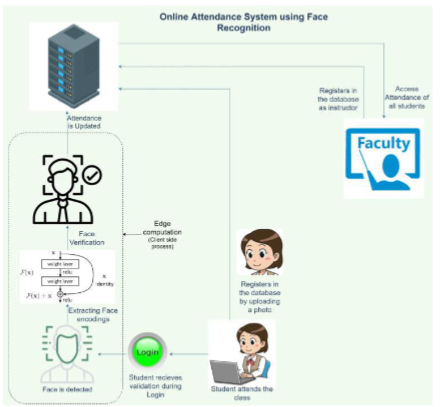IOATS: an Intelligent Online Attendance Tracking System based on Facial Recognition and Edge Computing
Keywords:
Edge Computing, Facial Recognition, Attendance Tracking, COVID19, Video Conferencing PlatformAbstract
Since the Coronavirus (COVID19) pandemic, all activities have been held digitally, necessitating the surveillance of guests' real-time attendance. Previously, online attendance included getting the list of attendees, which was inconvenient because many people chose to keep silent or leave the meeting completely. As a result, a technique for collecting attendance using facial recognition that can correctly identify participants who remain online for the duration of the lecture is required. The goal of this work is to develop a system named IOSTS, an intelligent online attendance tracking system, that can track attendance while using minimum bandwidth and maintaining user privacy. This proposed work is based on the concepts of facial recognition and edge computing. The entire utility will be run on the client's PC. From random experiments, it is observed that achieving an accuracy of 98 % in facial recognition. This new approach is a foolproof method of tracking attendance and increasing digital transparency.
Downloads
References
A. Pati, M. Parhi and B. K. Pattanayak, “COVID19 Pandemic Analysis and Prediction Using Machine Learning Approaches in India”, In Advances in Intelligent Computing and Communication, Springer, Singapore, 2021, pp. 307–316.
R. Olaniyan, O. Fadahunsi, M. Maheswaran, and M. F. Zhani, “Opportunistic Edge Computing: Concepts, opportunities and research challenges,” Future Generation Computer Systems, vol. 89. Elsevier BV, pp. 633–645, December 2018.
I. A. Ujan and I. A. Ismaili, "Biometric attendance system," The 2011 IEEE/ICME International Conference on Complex Medical Engineering, 2011, pp. 499-501.
N. K. Balcoh, M. H. Yousaf, W. Ahmed, M. I. Baig,” Algorithm for efficient attendance management: Face recognition based approach”, IJCSI International Journal of Computer Science, vol. 9, no. 4, pp. 146–150, 2012.
S. Chintalapati and M. V. Raghunadh, "Automated attendance management system based on face recognition algorithms," IEEE International Conference on Computational Intelligence and Computing Research, 2013, pp. 1-5.
D. Nithya, "Automated Class Attendance System based on Face Recognition using PCA Algorithm", International Journal of Engineering Research & Technology (IJERT) Volume 04, Issue 12 (December 2015).
Surekha, B., Nazare, K. J., Viswanadha Raju, S., & Dey, N. (2016). Attendance Recording System Using Partial Face Recognition Algorithm. Intelligent Techniques in Signal Processing for Multimedia Security, 293–319.
M. Arsenovic, S. Sladojevic, A. Anderla, and D. Stefanovic, "FaceTime — Deep learning-based face recognition attendance system," 2017 IEEE 15th International Symposium on Intelligent Systems and Informatics (SISY), 2017, pp. 000053-000058.
E. Rekha and P. Ramaprasad, "An efficient automated attendance management system based on Eigen Face recognition," 2017 7th International Conference on Cloud Computing, Data Science & Engineering - Confluence, 2017, pp. 605-608.
V. Suresh, S. C. Dumpa, C. D. Vankayala, H. Aduri, J. Rapa, (2019), "Facial Recognition Attendance System Using Python and OpenCV", Quest Journals - Journal of Software Engineering and Simulation, vol. 5, no. 2, pp. 18–29.
S. Kakarla, P. Gangula, M. S. Rahul, C. S. C. Singh, and T. H. Sarma, "Smart Attendance Management System Based on Face Recognition Using CNN," 2020 IEEE-HYDCON, 2020, pp. 1-5
V. Patil, A. Narayan, V. Ausekar, A. Dinesh, (2020), "Automatic Students Attendance Marking System Using Image Processing and Machine Learning", IEEE International Conference on Smart Electronics and Communication pp. 542–546.
T. Sharanya, U. Kasturi, P. Sucharith, T. Mahesh and V. Dhivya, (2020) ’Online Attendance using Facial Recognition’, IJERT International Journal of Engineering Research & Technology, Vol. 9, no.6, pp. 202–207.
S. Bussa, A. Mani, S. Bharuka, and S. Kaushik, “Smart Attendance System using OPENCV based on Facial Recognition,” International Journal of Engineering Research and, vol. V9, no. 03. ESRSA Publications Pvt. Ltd., Mar. 11, 2020.
K. He, X. Zhang, S. Ren, and J. Sun, "Deep Residual Learning for Image Recognition," 2016 IEEE Conference on Computer Vision and Pattern Recognition (CVPR), 2016, pp. 770-778.
S. Sharma, K. Shanmugasundaram and S. K. Ramasamy, "FAREC-CNN based efficient face recognition technique using Dlib," 2016 International Conference on Advanced Communication Control and Computing Technologies (ICACCCT), 2016, pp. 192-195
G.B. Huang, M. Ramesh, T. Berg, E. Learned-Miller, "Labeled Faces in the Wild: A Database for Studying Face Recognition in Unconstrained Environments", University of Massachusetts, Amherst, Technical Report, pp. 07–49, 2007.
A. Pati, M. Parhi and B. K. Pattanayak. (2021, January).” IDMS: An Integrated Decision Making System for Heart Disease Prediction.” In 2021 1st Odisha International Conference on Electrical Power Engineering, Communication and Computing Technology (ODICON) (pp. 1-6). IEEE.
A. Pati, M. Parhi and B. K. Pattanayak, (2022). “HeartFog: Fog Computing Enabled Ensemble Deep Learning Framework for Automatic Heart Disease Diagnosis.” In Intelligent and Cloud Computing (pp. 39-53). Springer, Singapore.
A. Pati, M. Parhi and B. K. Pattanayak, (2022). “IADP: An Integrated Approach for Diabetes Prediction Using Classification Techniques.” In Advances in Distributed Computing and Machine Learning (pp. 287-298). Springer, Singapore.
A. Bhandari, "AUC-ROC Curve in Machine Learning Clearly Explained," 16 06 2020. [Online]. Available: https://www.analyticsvidhya.com/blog/2020/06/auc-roc-curve-machine-learning/. [Accessed 13/08/2021]

Downloads
Published
How to Cite
Issue
Section
License
Copyright (c) 2022 Manoranjan Parhi, Abhinandan Roul, Bravish Ghosh, Abhilash Pati

This work is licensed under a Creative Commons Attribution-ShareAlike 4.0 International License.
All papers should be submitted electronically. All submitted manuscripts must be original work that is not under submission at another journal or under consideration for publication in another form, such as a monograph or chapter of a book. Authors of submitted papers are obligated not to submit their paper for publication elsewhere until an editorial decision is rendered on their submission. Further, authors of accepted papers are prohibited from publishing the results in other publications that appear before the paper is published in the Journal unless they receive approval for doing so from the Editor-In-Chief.
IJISAE open access articles are licensed under a Creative Commons Attribution-ShareAlike 4.0 International License. This license lets the audience to give appropriate credit, provide a link to the license, and indicate if changes were made and if they remix, transform, or build upon the material, they must distribute contributions under the same license as the original.





